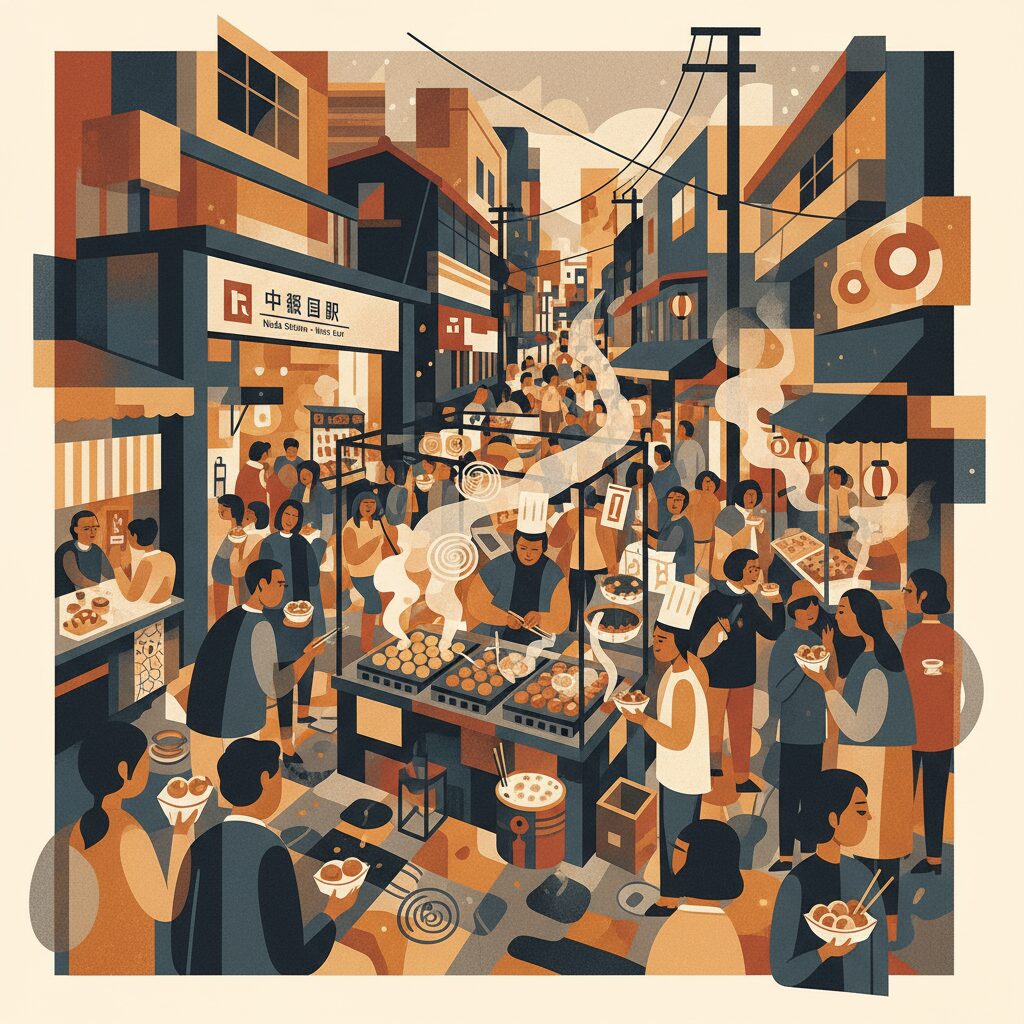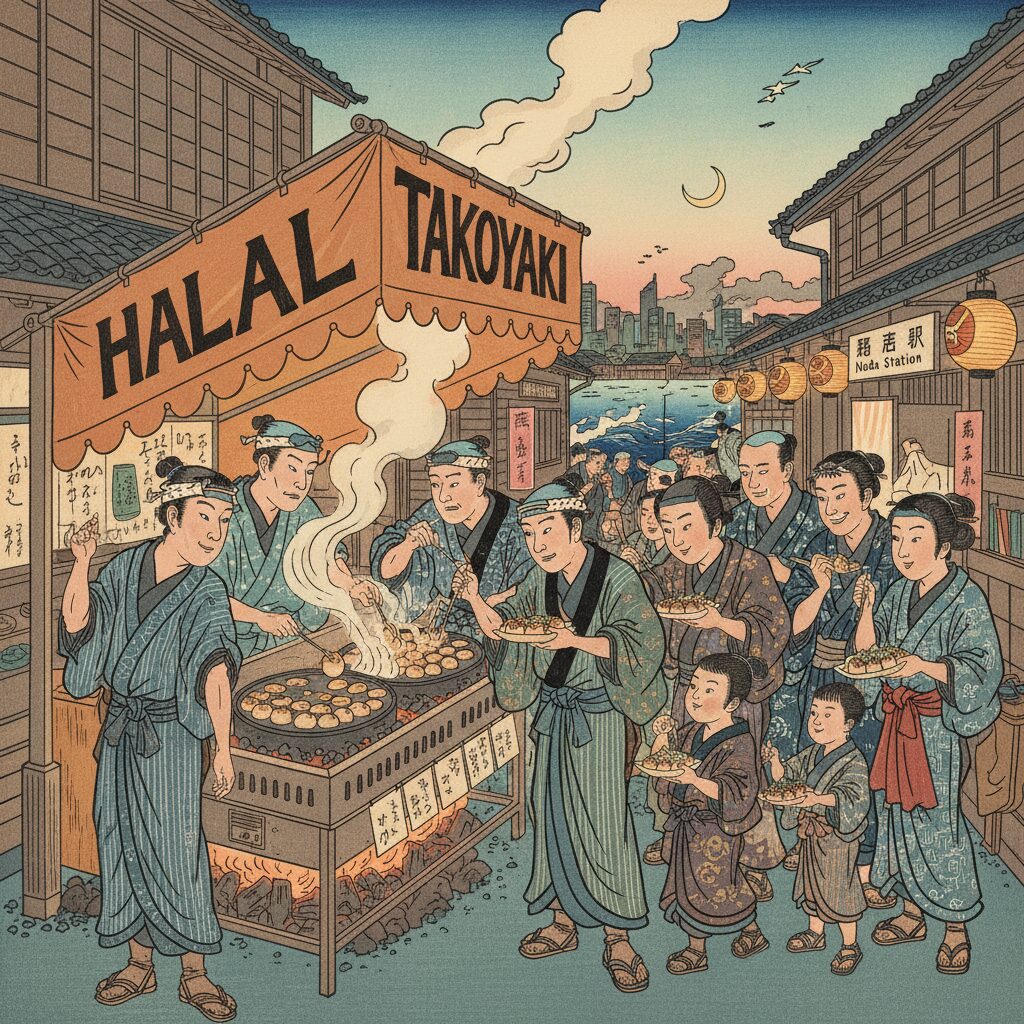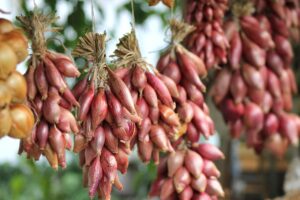Welcome to Osaka, the city that lives by the glorious creed of kuidaore, a joyful expression that translates to eating until you drop. This is Japan’s kitchen, a sprawling, vibrant metropolis where the air itself seems seasoned with the savory steam of street food stalls and the promise of another unforgettable meal. Here, food is not just sustenance; it’s a culture, an identity, and a passionate art form. Central to this culinary universe is takoyaki, the city’s undisputed icon. These golden-brown spheres of savory batter, cradling a tender piece of octopus within, are more than just a snack—they are a taste of Osaka’s soul. For decades, the sizzle of batter hitting the cast-iron pan and the rhythmic flick of the chef’s pick have been the soundtrack to life in these streets. Yet, for Muslim travelers, this quintessential Osakan experience has often been just out of reach, a delicious aroma with a hidden barrier. Traditional recipes frequently use ingredients that are not Halal, from pork-based elements in sauces to lard for frying, creating a silent exclusion from one of the city’s greatest joys. But the spirit of Osaka is one of welcome and innovation, and in a quiet, unassuming neighborhood just a stone’s throw from the bustling city center, a solution has blossomed. Tucked away near Noda Station is a culinary haven named Matsuri, a beacon for those who have longed to taste authentic Japanese cuisine without compromise. This is not just a place to eat; it is a destination where culinary tradition embraces inclusivity, proving that the heart of Osaka’s hospitality beats for everyone. Here, the quest for a truly Halal takoyaki experience finally finds its delicious conclusion.
After enjoying your Halal takoyaki, you can continue your exploration of the area with a peaceful cycling journey through Yodogawa Riverside Park.
The Soul of the Streets: Understanding Osaka’s Takoyaki Obsession

To truly understand Osaka, one must first grasp the essence of takoyaki. This is no exaggeration; it is a fundamental truth about the city. The story of takoyaki dates back to the 1930s, originating from a modest street stall and a spark of inventive brilliance. A vendor named Tomekichi Endo, inspired by a dish from the Akashi region called akashiyaki, chose to innovate. He took a simple egg-rich batter dumpling and transformed it by adding a piece of octopus, or tako, into its molten center. The result was an explosion of flavor and texture that captured the city’s imagination. It was affordable, quick, and incredibly delicious—the perfect food for a bustling city.
The magic of takoyaki lies in its striking contrasts. The outside is a delicate, golden-crisp shell that breaks with a satisfying crackle. Inside, the batter remains irresistibly creamy, almost molten—like a savory custard flooding the palate. At the heart is the octopus, with a firm, satisfying chew that grounds the whole experience. This textural harmony is then crowned with an artful array of toppings. A thick, sweet, and tangy takoyaki sauce—reminiscent of Worcestershire sauce but with a distinct Japanese twist—is generously brushed on top. A drizzle of creamy Japanese mayonnaise adds richness. A vibrant green dusting of aonori, or dried seaweed flakes, provides a subtle oceanic saltiness. Finally, a shower of paper-thin katsuobushi, or dried bonito flakes, is sprinkled over the hot spheres. As the heat rises, these delicate flakes dance and curl as if alive, adding a theatrical flourish and a deep, smoky umami flavor.
Watching takoyaki being made is a performance in itself. The chefs, true masters of their craft, work over large cast-iron griddles dotted with hemispherical molds. With practiced skill, they pour the creamy batter, drop in octopus pieces and other fillings like pickled ginger and green onion, and then the dance begins. Using a sharp metal pick, they deftly and rhythmically turn the batter balls, their hands moving in a blur. They coax the liquid batter, folding in the edges until perfect spheres form, each cooked to an even, golden brown. The air fills with the irresistible aroma of cooking batter and savory sauce, a siren call to anyone nearby. This is why finding a Halal version is so essential. The takoyaki experience is deeply woven into Osaka’s culture, and missing it means missing a part of the city’s very soul. The challenge has always been the hidden ingredients. The dashi stock in the batter may contain non-Halal elements. The sauce, often a closely guarded secret, may include mirin with alcohol or animal-derived flavorings. This culinary puzzle is exactly what Matsuri, located in the heart of Noda, aims to solve.
A Beacon of Welcome: Discovering Matsuri in Noda
The journey to Matsuri takes you away from the neon-lit canyons of Dotonbori and the upscale shops of Shinsaibashi, leading instead into a more genuine, everyday side of Osaka. Noda is a neighborhood pulsing with a local rhythm. To reach it, you’ll likely ride the JR Osaka Loop Line, a train that circles the city center like a protective embrace. Upon stepping off at Noda Station, you immediately sense a change in atmosphere. The towering skyscrapers give way to modest buildings, the city’s roar softens to a gentle murmur, and the streets fill not with tourists, but with locals—mothers cycling with children, shopkeepers sweeping fronts, and neighbors chatting warmly.
From the station, Matsuri is just a short, pleasant walk through clean, quiet streets, offering a glimpse into the residential heart of the city. The restaurant itself is modest from the outside, a humble storefront easily overlooked if you aren’t searching for it. Yet the signs are unmistakable: the Halal certification mark from the Japan Halal Foundation is proudly displayed, offering a clear and immediate welcome to Muslim visitors. This small but meaningful detail transforms any uncertainty into a sense of relief and eager anticipation.
Walking into Matsuri feels like being invited into a friend’s home. The space is cozy and warmly lit, in stark contrast with the cramped, hectic street food stalls. The decor is simple yet thoughtful, with wooden tables and Japanese art creating a calming, comfortable environment. The air is filled with the enticing aromas of soy sauce, dashi, and grilled meats—promising a delicious feast ahead. What truly distinguishes Matsuri, however, is its palpable spirit and passion. The owner, a visionary entrepreneur who recognized the need for authentic, Halal-certified Japanese cuisine, often greets guests personally. The staff are exceptionally friendly and attentive, skilled in hospitality that transcends language barriers. They understand their customers’ dietary needs intimately, happily explaining the menu, answering questions, and ensuring every diner feels completely comfortable. This is more than a business; it is a mission to share real Japanese flavors with the world, ensuring nobody is excluded. For Muslim travelers, this dedication is deeply reassuring. The restaurant even features a dedicated prayer space, a thoughtful and vital facility that highlights their commitment to the community. It allows visitors to observe their religious duties comfortably, without rushing back to their hotels, turning a simple meal into a relaxed and spiritually fulfilling experience.
The Main Event: A Deep Dive into Matsuri’s Halal Takoyaki

At last, the moment has arrived. The plate of takoyaki is placed before you, steaming and aromatic. At Matsuri, this dish is more than just food; it is a meticulously crafted work of art, the result of relentless effort to recreate a classic flavor profile within strict Halal guidelines. The presentation is impeccable. Eight perfectly round, golden-brown spheres rest in a traditional boat-shaped dish. They glisten beneath a generous lattice of specially formulated, alcohol-free takoyaki sauce and creamy Halal mayonnaise. The vibrant green of the aonori powder offers a striking contrast, while the katsuobushi flakes begin their mesmerizing dance atop the hot surface.
The first bite is a revelation. You use the provided toothpick to pierce the crispy shell, hearing a faint, satisfying crackle as it gives way—a testament to the chef’s skill in achieving the perfect exterior texture. Then, your palate is flooded with the rich, creamy, and wonderfully savory interior. The batter is light and airy, yet substantial, infused with deep umami from the carefully prepared fish-based dashi stock. It is piping hot, with a molten core of flavor that both soothes and excites. At the heart of this creamy dream lies the star of the dish: a generous, perfectly cooked piece of octopus. Tender rather than rubbery, it carries a subtle sweetness of the sea that balances the batter’s richness. It provides a delightful textural contrast—a firm, satisfying chew that makes every bite an adventure.
Matsuri’s genius shines brightest in the sauces. The takoyaki sauce is a masterful creation, capturing all the complex, tangy, and fruity notes of the traditional version. This deep, dark, savory glaze clings to every curve of the takoyaki balls. You savor layers of flavor—hints of sweetness, a touch of acidity, and profound umami depth—all achieved without a single non-Halal ingredient. The Halal mayonnaise is equally impressive, richer and creamier than many Western varieties, with a slight tang that cuts through the savory notes of the sauce and batter, bringing perfect harmony to the dish. Along with the oceanic aroma of the seaweed and the smoky finish of the bonito flakes, the combination is utterly sublime. This is no mere substitute or “close-enough” version. This is authentic, soul-satisfying Osakan takoyaki, made accessible through dedication and respect for both culinary tradition and religious faith. Each bite is a celebration—a moment of pure, unadulterated joy fulfilling a long-held wish for many visitors to this incredible city.
Beyond the Sphere: Exploring a Full Halal Washoku Menu
While the takoyaki undeniably serves as the main attraction drawing many to Matsuri’s door, stopping there means missing out on a vast array of other culinary delights. The restaurant’s name, meaning “festival” in Japanese, is perfectly appropriate, as its menu is a true celebration of Japanese cuisine, or washoku, all entirely Halal. This makes Matsuri more than just a takoyaki shop—it is a comprehensive destination for anyone seeking an authentic Japanese dining experience.
One standout item is their Halal ramen. Creating a delicious Halal ramen broth is famously challenging, as traditional recipes depend heavily on pork bones (tonkotsu) to achieve their rich, creamy flavor. Matsuri has admirably met this challenge with impressive results. Their broth, typically based on chicken or seafood, is simmered for hours to draw out every bit of flavor, resulting in a deep, complex, and satisfying soup. Whether you opt for shio (salt), shoyu (soy sauce), or miso, each bowl is a perfectly balanced masterpiece. The noodles are firm and springy, cooked just right, while the toppings include tender grilled chicken or beef slices, seasoned bamboo shoots, a soft-boiled egg with a luscious jammy yolk, and crisp nori seaweed. For many, a steaming bowl of authentic ramen is as essential to the Japan experience as takoyaki, and Matsuri executes it flawlessly.
Another Osakan specialty skillfully recreated here is okonomiyaki. Often called a savory Japanese pancake, this dish epitomizes comfort food. The name itself means “grilled as you like it,” and features a hearty mix of batter, shredded cabbage, and other ingredients cooked on a flat-top teppan. Matsuri’s version is delightful—the pancake is fluffy inside and beautifully browned outside, full of fresh, crunchy cabbage. It’s then generously coated with the same tangy Halal sauce used for the takoyaki, drizzled with creamy mayonnaise, and topped with aonori and dancing bonito flakes. This messy, joyful dish perfectly captures Osaka’s unpretentious and hearty food culture.
The menu continues to impress with other classics. Their chicken karaage is a must-try—bite-sized pieces marinated in a savory blend of soy sauce, ginger, and garlic, coated in a light batter, and fried to crispy perfection. Juicy and succulent inside with a satisfyingly crunchy exterior, they make for an addictive appetizer or side. For those seeking a more refined option, the restaurant also offers beautifully prepared bento boxes and other traditional dishes. Being able to sample such a wide variety of iconic Japanese foods in one place—with the full assurance that everything is Halal—is a tremendous gift for travelers. It elevates a simple meal into a rich culinary journey through the heart of Japan.
The Charm of the Neighborhood: What to Do Around Noda

A trip to Matsuri also offers a chance to explore a less-visited part of Osaka. The Noda neighborhood, within the larger Fukushima ward, combines residential tranquility with lively local commerce. Rather than heading straight back to the city center after your meal, take some time to stroll and absorb the atmosphere. The ideal starting point is the local shotengai, a covered shopping arcade. These arcades are the heartbeat of many Japanese communities, and those near Noda Station are refreshingly genuine. Here, you won’t encounter souvenir shops or tourist traps; instead, you’ll find a genuine slice of Osakan life.
As you walk through the arcade, take in the rhythm of everyday trade. Family-run tofu shops prepare fresh tofu each morning, traditional sweet shops offer mochi and other Japanese treats, small greengrocers display impeccably arranged fruits and vegetables, and fishmongers showcase the day’s fresh catch. The air is a blend of aromas—the sweetness of baked goods, the savory scent of grilling fish, and the earthy smell of fresh produce. The sounds are equally engaging: shopkeepers warmly greeting regular customers, the gentle hum of bicycles on the covered street, and neighbors chatting cheerfully about local news. This sensory experience provides a richer insight into local culture than any museum can.
Beyond the shotengai, the neighborhood holds additional delights. Twisting side streets reveal small, well-kept local shrines and temples, perfect for quiet reflection. You might come across a small park where children play or a quaint, old-fashioned coffee shop (kissaten) ideal for a post-meal brew. Historically part of Osaka’s central wholesale market area, Noda still preserves a spirit of commerce and community despite the market relocating. Exploring Noda invites you to slow down, observe the subtle rhythms of daily life, and feel part of the city rather than just a passing visitor. It offers a serene and beautiful contrast to the high-energy buzz of Osaka’s more famous districts, making your culinary visit to Matsuri a richer and more memorable journey.
A Final Taste of Osakan Hospitality
Osaka’s identity is deeply intertwined with its cuisine, yet it is equally shaped by the nature of its people—renowned for being warm, straightforward, and hospitable. Visiting Matsuri offers an opportunity to experience the very essence of this Osakan spirit. It is a place created not merely as a business venture, but from a sincere desire to share and connect. The development of a fully Halal menu, featuring some of Japan’s most cherished and intricate dishes, reflects an extraordinary level of research, dedication, and respect. It stands as a form of culinary diplomacy, breaking down barriers and building bridges one delicious dish at a time.
For a first-time visitor to Japan, navigating a new culture can be both thrilling and intimidating. For a Muslim traveler, there is an added complexity—a constant mindfulness of dietary restrictions that can sometimes create a sense of separation from the local culture. Establishments like Matsuri bridge that gap. They offer a space where you can feel at ease, free from doubt or concern, and simply revel in the joy of discovery. Here, you are more than just a customer; you are a welcomed guest, invited to enjoy a feast thoughtfully prepared with you in mind.
So, as you plan your journey to the remarkable city of Osaka, let the promise of authentic Halal takoyaki lead you to the lovely district of Noda. Come for the food and the chance to savor the city’s most iconic dish. But stay for the experience—stay for the warm hospitality, a glimpse into local life, and the profound sense of connection that arises from sharing a meal crafted with passion and care. In a city famous for its endless dining options, Matsuri ensures that this joyful invitation is extended to all, offering a true taste of Osaka’s heart—generous, inclusive, and utterly delicious.


